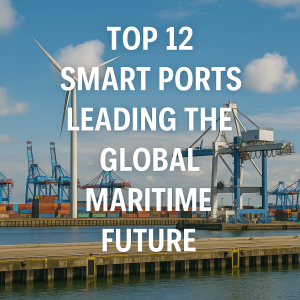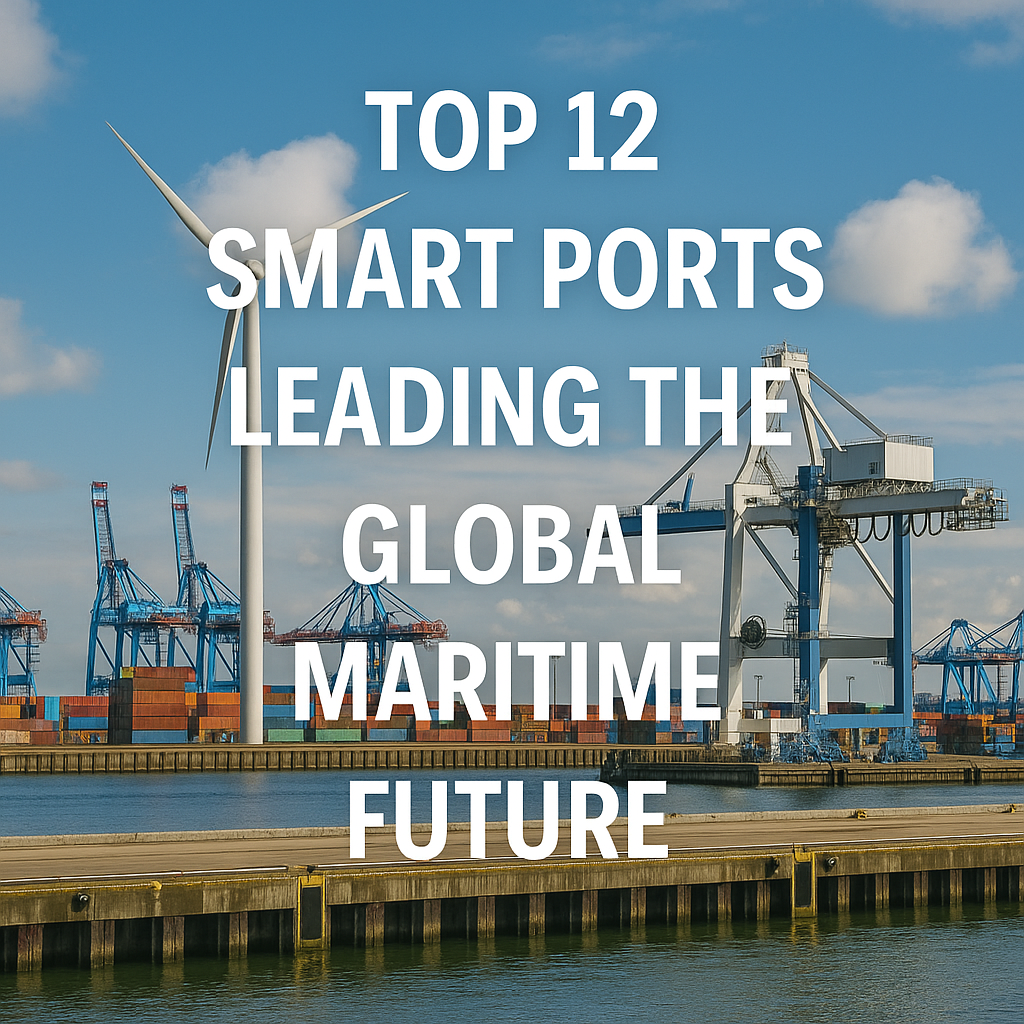
Discover the top 12 smart ports revolutionizing global maritime logistics in 2025. Explore how AI, automation, and sustainability are transforming operations at the world’s most advanced seaports.
Smart ports are no longer a concept of the future—they’re defining it. As the maritime industry faces increasing pressure to decarbonize, digitalize, and deliver faster, a new class of intelligent seaports has emerged at the frontline of transformation.
From autonomous vehicles and blockchain-based customs systems to AI-powered berth planning and real-time cargo visibility, the smartest ports in the world are rewriting how trade flows. These ports are not just installing technology—they’re integrating it into the fabric of port ecosystems to make operations cleaner, faster, and safer.
This guide explores the top 12 smart ports leading the global maritime future in 2025. We’ll examine the innovations they’re deploying, the problems they’re solving, and the trends shaping their evolution.
Why Smart Ports Matter in Modern Maritime Operations
According to the International Maritime Organization (IMO), over 11 billion tons of cargo are moved by sea each year. With global trade expected to increase by over 3.3% annually (UNCTAD, 2024), traditional ports can no longer keep pace without digital transformation.
Smart ports help solve critical industry challenges:
-
Congestion reduction through automated gate and yard systems
-
Real-time data integration across port authorities, shipping lines, and customs
-
Energy efficiency via renewable-powered terminals and AI-controlled cranes
-
Emissions tracking aligned with the IMO GHG strategy and EU ETS regulations
-
Predictive maintenance to reduce vessel idle times and improve safety
As highlighted by the European Sea Ports Organisation (ESPO) and the International Association of Ports and Harbors (IAPH), smart ports are key to meeting the twin goals of sustainability and operational efficiency.
–
What Defines a “Smart Port”?
A smart port leverages digital technologies and data-driven processes to optimize maritime logistics. It combines elements of Industry 4.0, Green Port thinking, and Port Community Systems (PCS) to improve cargo flow, security, and environmental compliance.
Key features include:
-
IoT sensors on cranes, containers, and vehicles
-
5G connectivity for seamless communication across terminals
-
Digital twins to simulate infrastructure and vessel interactions
-
Automated guided vehicles (AGVs) and remote-controlled STS cranes
-
Blockchain and AI for secure and optimized customs, tracking, and scheduling
–
The Top 12 Smart Ports in 2025
1. Port of Rotterdam (Netherlands)
Europe’s largest port is arguably the smartest. The Port of Rotterdam Authority, in collaboration with IBM and Cisco, operates a digital twin of the port for real-time operational monitoring. Autonomous shipping trials are underway, and the port is a hub for hydrogen fuel logistics.
Key Features:
-
AI-based berth planning
-
Predictive maintenance systems
-
Real-time cargo visibility through PortXchange
2. Port of Singapore
The Maritime and Port Authority of Singapore (MPA) has transformed the port into a global tech leader. The Tuas Mega Port, partially opened in 2022, is fully automated with unmanned yard cranes, AI for resource optimization, and digital twin technology.
Key Features:
-
AI-powered vessel ETA forecasting
-
5G port-wide connectivity
-
Smart port planning via MPA’s digitalPORT@SG™
3. Port of Hamburg (Germany)
Hamburg’s SmartPORT initiative integrates renewable energy systems, traffic flow control, and IoT devices for efficiency. Its Port Community System (PCS) is one of Europe’s most connected.
Key Features:
-
Blockchain-based cargo clearance
-
Smart lighting and sensor networks
-
Real-time truck slot management
4. Port of Antwerp-Bruges (Belgium)
After merging with Zeebrugge in 2022, Antwerp became Europe’s second-largest port. It uses drones for aerial surveillance, has a digital twin, and is piloting carbon-neutral fuel hubs.
Key Features:
-
Digital port ecosystem (NxtPort)
-
AI-powered traffic optimization
-
Hydrogen fueling for inland vessels
5. Port of Los Angeles (USA)
A leader in North America, the Port of LA uses the Port Optimizer™, an AI system co-developed with GE Transportation, to track over 80% of U.S.-bound container flows.
Key Features:
-
Integrated terminal operations
-
Emissions dashboards
-
Port Community System for shippers and truckers
6. Port of Busan (South Korea)
As Asia’s fifth-busiest port, Busan is rolling out a fully autonomous container terminal by 2026. It uses AI, IoT, and robotic cranes integrated into its operations.
Key Features:
-
Smart quay cranes
-
Deep learning for cargo forecasts
-
Integrated intermodal tracking system
7. Port of Valencia (Spain)
Valencia’s ValenciaportPCS connects shippers, terminals, and authorities with real-time updates. The port is experimenting with green hydrogen and electrified berth infrastructure.
Key Features:
-
Digital twin for vessel calls
-
AI for berthing assignments
-
Autonomous electric shuttles
8. Port of Shanghai (China)
The world’s largest port is embracing AI and IoT to power Yangshan Deep Water Port, where fully automated terminals operate with minimal human input.
Key Features:
-
AI-based traffic flow optimization
-
Integrated smart customs and quarantine inspections
-
Blockchain-based bill of lading systems
9. Port of Gothenburg (Sweden)
Scandinavia’s largest port uses autonomous vehicles and a digital green corridor system for data exchange between stakeholders and authorities.
Key Features:
-
AI for cargo traffic prediction
-
Shore power across major terminals
-
Real-time environmental performance indicators
10. Port of Yokohama (Japan)
Known for innovation, Yokohama’s Y-PORT program blends smart infrastructure with climate adaptation tools. AI, big data, and satellite tracking are used for urban-port resilience.
Key Features:
-
Smart logistics zone
-
Digital twin for port planning
-
Integrated flood management system
11. Port of Vancouver (Canada)
Vancouver is focusing on data transparency and green shipping corridors. Its port optimizer tool tracks emissions, cargo velocity, and truck turnaround times.
Key Features:
-
Port Community Dashboard
-
Smart gateway terminal automation
-
Carbon scorecard for shippers
12. Port of Melbourne (Australia)
Melbourne is leading smart port development in Oceania with real-time container tracking, AI cargo prediction, and the Port Rail Transformation Project.
Key Features:
-
IoT-equipped terminals
-
Blockchain logistics pilot with IBM
-
Smart rail scheduling
–
Case Studies
Rotterdam’s Digital Twin Revolution
By integrating digital twins and AI for predictive berth planning, the Port of Rotterdam reduced berth waiting time by 20% between 2022 and 2024. This directly impacted fuel consumption and emissions.
Singapore’s AI ETA Forecasting
Singapore’s MPA Smart Port Challenge resulted in the deployment of AI-powered ETA forecasting tools, improving turnaround predictability and reducing idle anchorage time by up to 30%.
–
FAQ
1. What exactly is a smart port?
A smart port integrates digital tools like IoT, AI, and automation to streamline cargo flow, reduce emissions, and improve safety across all operations.
2. How do smart ports reduce emissions?
By optimizing routes, reducing waiting times, using electric vehicles, and powering terminals with renewables—smart ports support IMO’s decarbonization goals.
3. Are smart ports more expensive to operate?
Initial investments are high, but long-term savings in energy, manpower, and efficiency generally outweigh the costs. Many ports receive government and EU funding.
4. How do smart ports impact shipping companies?
They allow for better scheduling, visibility, and reduced dwell time. Carriers can plan more efficient voyages with fewer delays.
5. Are all large ports becoming smart ports?
Not necessarily. While many are on the path to digitalization, full smart port integration varies by region, funding, and national strategy.
Conclusion
Smart ports are setting a new benchmark for global maritime logistics. They represent a shift from traditional manual processes to automated, data-driven ecosystems that are greener, faster, and more resilient.
In 2025, these 12 ports are leading that charge—not just by adopting technologies, but by transforming how people, cargo, and infrastructure interact. For shipping companies, freight forwarders, and maritime professionals, engaging with smart ports is no longer optional—it’s a competitive necessity.
🚢 Adapt, connect, and thrive in the digital port era.


This article will assist the internet visitors for creating new web site or even a blog from start to
end.